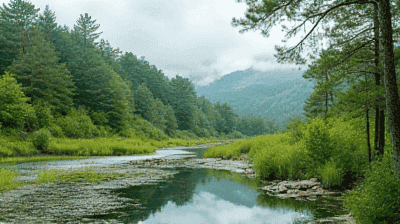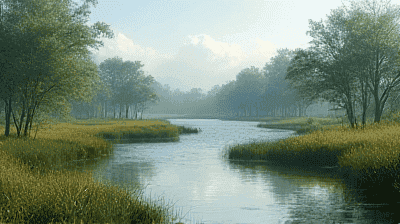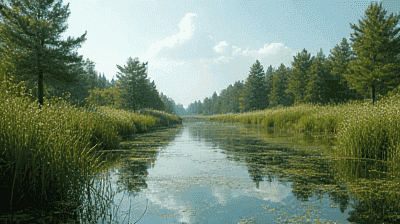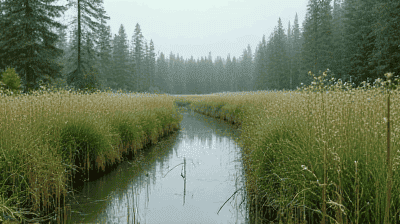
Wetlands are among the most productive ecosystems on the planet, serving as critical buffers against pollution and playing an integral role in the health of both terrestrial and aquatic environments. These unique ecosystems provide numerous ecological services, with one of the most vital being their ability to filter and purify polluted water. As human activities increasingly threaten water quality through urban development, agriculture, and industrialization, understanding the significance of wetlands in pollution control becomes paramount.
Wetlands are areas where water is present for extended periods, either at or near the surface, creating unique conditions that support a diverse array of plant and animal life. They can be classified into different types, including:
Marshes: Characterized by herbaceous plants like grasses, sedges, and reeds, marshes can be freshwater or saltwater wetlands. They are often found along the edges of rivers and lakes.
Swamps: Dominated by woody plants such as trees and shrubs, swamps can be further divided into freshwater and saltwater types. They often have slow-moving or stagnant water and support diverse wildlife.
Bogs and Fens: These are peat-forming wetlands that accumulate organic material. Bogs are acidic and nutrient-poor, while fens are more alkaline and support a wider range of plant species.
Estuaries: These wetlands occur where freshwater from rivers meets saltwater from the ocean. Estuaries are rich in nutrients and serve as nurseries for many marine species.
Wetlands are invaluable ecosystems that provide a range of ecological, economic, and social benefits:
Water Quality Improvement: Wetlands naturally filter pollutants, sediments, and excess nutrients from water before it enters lakes and rivers.
Flood Mitigation: Wetlands act as natural sponges, absorbing excess rainwater and stormwater runoff, mitigating the impacts of flooding.
Habitat for Biodiversity: Wetlands support a diverse array of plant and animal species, making them hotspots for biodiversity.
Carbon Storage: Wetlands play a role in carbon sequestration, helping to mitigate climate change by capturing and storing carbon dioxide.
Recreational Opportunities: Wetlands provide spaces for recreational activities such as birdwatching, fishing, and hiking, contributing to human well-being.

Wetlands filter water through a combination of physical, chemical, and biological processes:
Sedimentation: As water flows through wetlands, sediments settle out of the water column and accumulate on the wetland floor. This process reduces water turbidity and removes particulates.
Plant Uptake: Wetland vegetation absorbs nutrients such as nitrogen and phosphorus from the water. These nutrients are utilized for plant growth, reducing their availability for algal blooms in downstream water bodies.
Microbial Activity: Microorganisms in wetland soils break down organic matter and pathogens. Certain bacteria, for instance, can convert harmful nitrogen compounds into harmless forms that are less likely to contribute to pollution.
Radical Chemical Reactions: Chemical processes in wetlands can transform and neutralize pollutants. For example, anaerobic bacteria thrive in wetland soils, facilitating the denitrification process that converts nitrates into nitrogen gas, which is released into the atmosphere.
Natural Filtration through Substrate: The substrate of wetlands, often composed of sands, silts, and organic materials, acts as a physical filter, trapping pollutants and preventing them from entering water bodies.
The journey of water in wetlands begins with rainfall or surface runoff, which enters the wetland. As this water stands in the wetland environment, various filtering processes occur:
Inflow: Runoff from agricultural fields, urban areas, and other sources can carry pollutants, including pesticides, fertilizers, and heavy metals. As this water enters the wetland, it begins undergoing filtration.
Interaction with Vegetation: Wetland plants play a crucial role in filtration. As water moves through the roots and stems of plants, nutrients and pollutants are absorbed or decomposed by microorganisms in the soil.
Outflow: After undergoing the filtering processes, the water exits the wetland into adjacent water bodies, significantly cleaner than before, thus protecting downstream ecosystems.
Wetland plants, characterized by their ability to thrive in saturated soils, are critical players in the filtration process:
Cattails (Typha spp.): Cattails are effective at absorbing excess nutrients and can thrive in a variety of wetland conditions.
Reed Sweetgrass (Glyceria maxima): This plant helps stabilize sediment and improve water clarity while taking up nutrients.
Sedges (Carex spp.): Sedges have deep root systems that can filter pollutants while providing habitat for wildlife.
Wetland Grasses: Many grasses naturally filter out sediments and nutrients through their fibrous root systems.
Wetlands are among the most biodiverse ecosystems on the planet. They provide habitats for countless species, including:
Birds: Many migratory birds rely on wetlands for nesting and feeding. Wetlands serve as crucial stopover points during migration.
Aquatic Life: Fish, amphibians, and invertebrates thrive in wetlands, contributing to the richness of aquatic ecosystems.
Terrestrial Animals: Many mammals and reptiles use wetlands as critical habitats for hunting, breeding, and shelter.
Wetlands act as natural buffers, mitigating flooding by:
Absorbing Excess Water: During heavy rain events, wetlands can absorb and store large amounts of water, reducing the risk of downstream flooding.
Storing Water Slowly: Wetlands release stored water gradually, helping to maintain streamflow during dry periods and reduce the intensity of flood events.

Despite their ecological importance, wetlands face numerous threats:
Urbanization leads to the draining and filling of wetlands for construction and infrastructure projects. This loss of wetland area disrupts natural filtration processes and habitat availability.
Intensive agricultural practices contribute to nutrient runoff and contaminant loads that overwhelm wetland capacities. The use of fertilizers and pesticides can lead to increased pollution levels.
Climate change poses a significant threat to wetland ecosystems. Rising temperatures, altered precipitation patterns, and sea-level rise can lead to habitat loss, decreased water quality, and changes in species composition.
Invasive species can outcompete native wetland vegetation, disrupting nutrient cycling and diminishing the ecosystem's overall health.
Strengthening policies and regulations that protect existing wetlands is crucial. This includes enforcing laws against wetland degradation and promoting conservation initiatives.
Restoring degraded wetlands can enhance their water filtration abilities. Successful restoration projects often include:
Replanting Native Vegetation: Reintroducing native plant species that are effective in nutrient uptake and sediment stabilization.
Removing Invasive Species: Managing or eliminating invasive species to restore ecological balance.
Reducing River Runoff: Implementing best management practices in surrounding landscapes to minimize nutrient loading into wetlands.
Engaging local communities in wetland conservation efforts can foster a sense of stewardship. Educational outreach, volunteer restoration days, and citizen science projects can empower communities to take action.
Investing in research to understand wetland processes better and exploring new restoration techniques can lead to improved management practices that enhance wetland functions in filtering pollutions.

Wetlands are remarkable ecosystems with an unparalleled ability to filter polluted water and provide numerous ecological services. As the pressures of urbanization, agriculture, climate change, and pollution increase, the preservation and restoration of wetlands become increasingly vital.
By understanding the essential role wetlands play in protecting water quality and biodiversity, we can advocate for their conservation and work towards creating policies that prioritize these ecosystems. Collaborative efforts between governments, NGOs, and local communities are key to ensuring that wetlands continue to thrive as natural filters and habitat providers for generations to come.